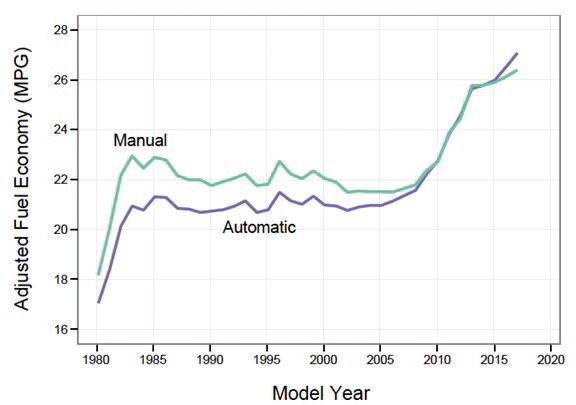When I last wrote about the mileage gap between automatic and manual transmissions (
December 2014 TLT), that gap was rapidly disappearing. According to the latest report from the U.S. Environmental Protection Agency, the automatic is now the more fuel-efficient choice!
Figure 1 specifically compares the fuel economy of automatic and manual transmission options where both transmissions were available in one model with the same engine. Two contributing factors to this trend are that automatic transmission design has become more efficient (using earlier lockup and other strategies), and the number of gears used in automatic transmissions has increased much quicker than in manual transmissions.
 Figure 1. Comparison of manual and automatic transmission adjusted fuel economy. (Source: U.S. EPA. Report EPA-420-R-18-001, Light Duty Automotive Technology, Carbon Dioxide Emissions, and Fuel Economy Trends: 1975-2017, January 2018.)
Figure 1. Comparison of manual and automatic transmission adjusted fuel economy. (Source: U.S. EPA. Report EPA-420-R-18-001, Light Duty Automotive Technology, Carbon Dioxide Emissions, and Fuel Economy Trends: 1975-2017, January 2018.)
In fact, starting last year the average number of forward gears in U.S. transmissions in cars is about 5.9 for manuals while automatics are averaging 6.3 forward gears with 10-speed transmissions in production and even more forward speeds in development. For example, both Ford and Honda have patented versions of an 11-speed automatic transmission.
Another big change is the mix of manual versus automatic transmission sold in the U.S. Manuals represented about 35% of production in 1980. That share fell to about 7% in 2012 and to 2.2% in 2016. At this rate, it won’t be long before the stick shift joins such automotive relics as the carburetor and the running board.
Among the many contributions of tribologists to the increase in forward speeds is a new generation of automatic transmission fluid (ATF). The Ford designation for the new ATF is Mercon ULV, which stands for ultra-low viscosity. Much like engine oil, reducing the viscosity of transmission fluid reduces the energy loss during flow and in hydrodynamic components. The viscosity of Mercon ULV is roughly half that of traditional ATFs.
Beginning with the 2017 model year, a 10-speed transmission, developed jointly by General Motors and the Ford Motor Co., has been available in the Ford F150 pickup truck and the Chevrolet Camaro. Exactly how much this has improved fuel economy in these vehicles is unclear, but based on published data the improvement is around 4% or about one additional mile per gallon of gasoline for both vehicles.
So by all means enjoy driving a stick if that is your preference. You can still note that a car with a manual transmission costs less than a comparable vehicle with an automatic transmission, a manual transmission is more fun to drive, and manuals are less mechanically complicated than automatics, therefore easier to maintain and less expensive to repair.
Thanks to the automotive tribologist, however, don’t claim that you are doing it for the fuel economy. In fact, starting in the last few years, you are actually wasting fuel!